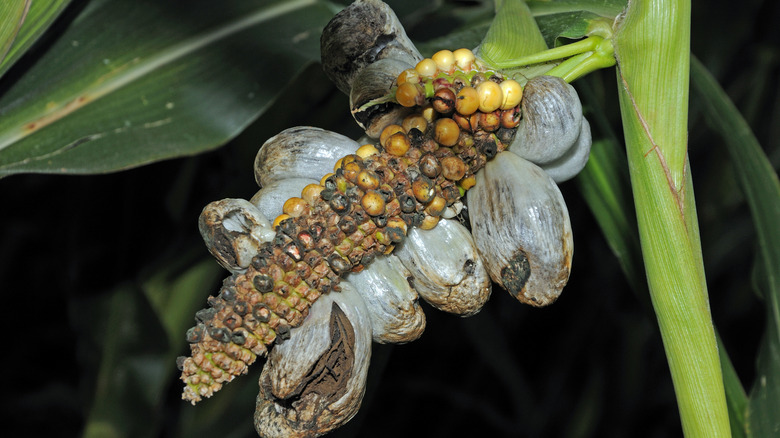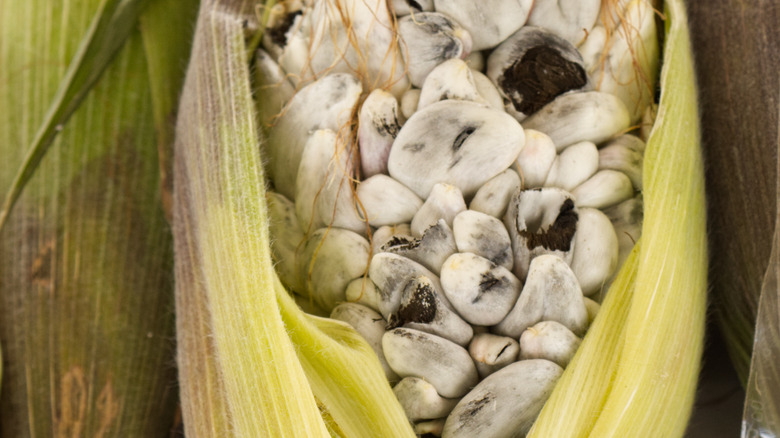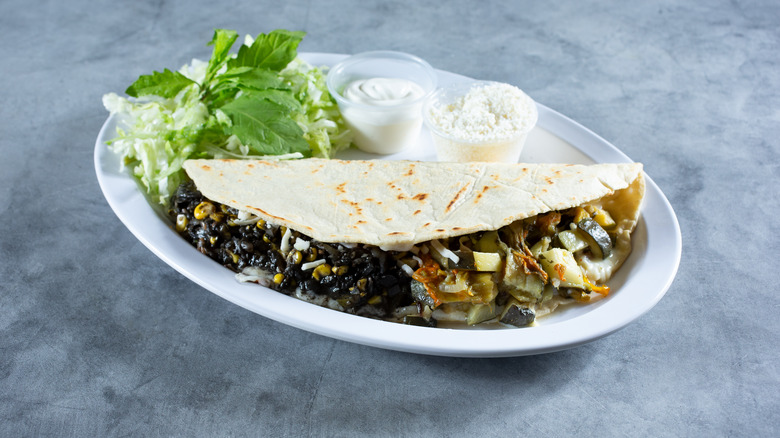Why You Should Never Buy Cheap Huitlacoche
When life gives you lemons, make lemonade. When life sends a parasitic fungus to engulf your entire corn crop, consider making it a national delicacy. We're talking about huitlacoche, an ingredient native to Central America that is commonly referred to as the "Mexican truffle." This fungus overtakes corn untreated by pesticides, particularly after rainy periods conducive to fungal growth. The result is a rare and delicious truffle-like treat, often called "black gold" in culinary circles.
In the U.S., huitlacoche is hard to find and often referred to as "corn smut," being actively eradicated wherever possible. In Mexico, however, these rather grotesque-looking growths are considered a delight and are sometimes even encouraged.
The flavor of huitlacoche can range from earthy and nutty to smoky and even sweet, similar to that of a black truffle. Like black truffles, however, huitlacoche can be difficult to obtain and expensive when available. Therefore, it's important not to skimp on the price when you find it; the inexpensive, canned variety is often slimy and lacks the intricate flavor of the fresh, market-price version.
Cheap huitlacoche just doesn't taste the same
Huitlacoche grows by attaching itself to unripe ears of corn and feeding off the sweet kernels. It develops into a dramatic structure that looks blue-gray on the outside and black on the inside. Similar to truffles and other prized fungi, its growth is unpredictable, making it difficult to know where you'll find it or how much it will cost. However, it is typically in season during the wetter months, which range from July to September.
Huitlacoche generally sells for up to $20 per pound, and should be consumed quickly. After a week, it starts to lose its flavor and takes on a mushy texture and unpleasantly pungent aroma. If you manage to find a source that sells huitlacoche, ensure that the texture of the fungus is firm or springy, and that it doesn't appear to be rotting. If it's priced significantly below the market rate, it may be old, frozen, or dried — and while huitlacoche can be frozen, freezing it alters its taste. Essentially, if a deal looks too good to be true, it probably is.
Frozen, dried, and canned huitlacoche
Much of the huitlacoche sold commercially is canned and can be purchased from online retailers such as Amazon, or you may even find it in your local grocery store — popular company Goya Foods offers a version. The canned stuff, however, is generally considered vastly inferior, as it sometimes contains the unripe corn kernels from the original plant. It is likely to have lost much of its flavor and may even be pre-seasoned before packaging. The soft, springy texture of fresh huitlacoche also often turns slimy once canned.
Huitlacoche is also available for purchase in frozen form, although this version often commands prices that are sometimes double those of fresh huitlacoche bought in Mexico. These vacuum-sealed, frozen packages can be bought from select online sellers and used much like you would use fresh huitlacoche. Huitlacoche can also be dried, later rehydrated, and used similarly to how you would rehydrate and cook with ingredients like shiitake mushrooms. However, this method is much less common. Therefore, when shopping for huitlacoche, you really should aim to buy it as fresh as possible if you want to experience its highly-prized flavor and texture, regardless of the price.



